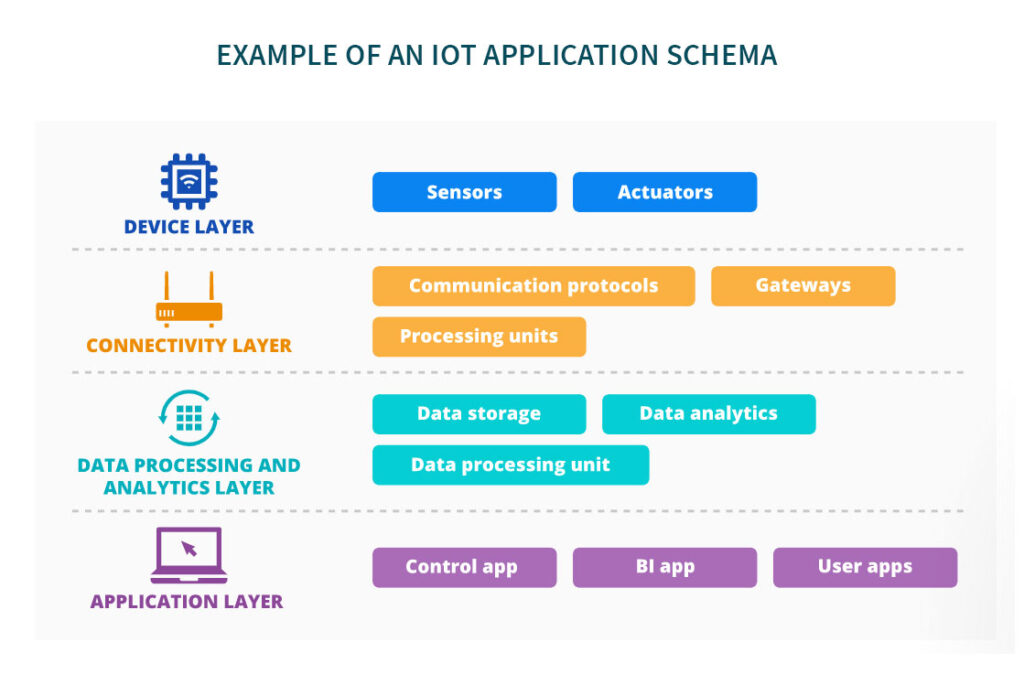
IoT Application Testing
IoT App Testing: the Summary
IoT testing includes functional and integration testing relevant to the specifics of distributed architectures, performance testing to check how the app handles large volumes of streaming data, security testing at the application, gateway, and IoT device levels.
Sample lineup of an IoT testing team: a test lead and test automation lead, manual and test automation engineers, a cyber security expert.

IoT App Testing Plan
The actual IoT testing setup plan will vary depending on the IoT solution’s requirements, the chosen development model, the current SDLC stage of your IoT project.
However, our testing experts have outlined some common stages to go through.
1. Designing IoT application testing process
A QA manager should be assigned as early as requirements specification development to ensure IoT functional requirements are designed in a testable way. Typically, the requirements are drawn up in a form of user stories.
The QA manager should decide how often a future QA team and the IoT development team need to collaborate to ensure relevant test cases’ prioritization, efficient defects’ management and regression testing.
Then, the QA manager should carefully consider possible IoT testing risks and design an all-around risk mitigation plan for your project. Among the risks there can be:
- Non-scalable, incomplete, improperly configured IoT test environment not fully reflecting the actual hardware configurations, lacking simulators or virtualization tools.
- Improper test automation frameworks’ choice and configuration.
Lack of IoT testing talents to promptly create and execute test cases addressing potential IoT-specific quality issues
2. Preparing for IoT app testing
Preparation for the IoT application testing process differs based on the sourcing model you opt for: in-house testing or outsourced testing.
2.1. Preparing for in-house IoT app testing
The assigned QA manager designs an overall IoT test strategy and plan, including effort estimation. As an IoT system’s architecture is prone to changes, the QA manager needs to regularly revise and update the test artifacts accordingly.
Then, the manager assembles an IoT testing team or teams.
Testing types that our experts consider relevant for any IoT application test plan
Functional testing
Test engineers validate the functionality of:
- Each IoT app component in isolation, sending test input events to each component to validate its output and behavior against requirements.
- End-to-end workflows of the entire IoT application.
- IoT app’s UI components, as soon as the UI is ready.
- Entire IoT system under specific network configurations and compelling real-life environments, during IoT field testing.
Integration testing
Test engineers validate:
- Flawless communication between different IoT app components and their tech stack compatibility.
- End-to-end enterprise workflows, as IoT solutions are often integrated with enterprise solutions (e.g., asset tracking and monitoring, field service applications, ERP, CRM, a data warehouse).
Quality data transfer between the IoT app and its third-party integrations to ensure that the data changed in one system is altered accordingly in all the connected systems, and the relevant change history is available.
Security testing
To ensure an IoT application’s resilience to hacker attacks, a cyber security engineer reviews the security of the system architecture, performs the vulnerability assessment and penetration testing.
To safeguard the entire IoT system’s cyber-security, you can also opt for the security testing of:
- IoT field gateways (validating the communication channel security and proper data encryption).
- IoT devices (examining the devices’ firmware and its upgrade process for vulnerabilities, reviewing the boot process from security perspective).
Performance testing
Additionally, your IoT test plan may include performance testing to:
- Measure the IoT app’s performance metrics (e.g., latency, throughput, response time, CPU utilization).
- Validate the stability of the entire application’s functioning and graceful degradation under stress load, changing operational and network conditions (like intermittent failures or the loss of network connectivity).
- Consider the effects of thousands of devices continuously sending and receiving data.
2.2. Vendor selection for outsourced IoT testing
If you realize your in-house resources are insufficient for overarching IoT app testing, you can consider its outsourcing, as it proves to be more cost-effective than hiring and training the additional test engineers on payroll.
To select a fitting vendor, you should:
- Design a comprehensive request for proposal (RFP) in line with your IoT solution’s specific requirements and architecture.
- Look for QA vendors with successful IoT testing projects in your domain.
- Consider the testing vendors’ tech stack and availability of human resources to meet your needs.
- Shortlist 3-5 vendors with eligible experience and resources.
- Share your IoT testing RFP with shortlisted vendors to get their cost estimations and an IoT testing presentation. This way, you can understand the vendors’ approach to an IoT testing strategy, testing teams’ lineup, testing toolkit, the planned test automation involvement.
- Negotiate an SLA and IoT testing cost with the matching vendor.
3. IoT testing launch
To get IoT testing started, testing teams design test cases and develop test scripts. Then, to check the end-to-end entire system’s functioning, an IoT test lab is created with the help of chosen service virtualization tools and simulators.
Professional IoT Testing Services
IoT testing consulting
- Design a general test strategy and plan for the entire IoT application and test plans for each module.
- Create a test automation architecture for IoT system’s components.
- Help select optimal IoT testing frameworks and tools.
- Provide estimation and costs breakdown for IoT testing efforts.
- Advise on an optimal sourcing model for your IoT testing project.
Perform analysis and mitigation of potential IoT application testing issues, in case of an ongoing project.
IoT testing outsourcing
Design the IoT testing process: a test strategy and plan for the entire IoT app and for specific modules; a test automation architecture with regard to the specifics of each IoT app component; a tailored testing toolkit.
Set up and maintain the IoT test lab, generate and manage IoT test data.
Develop, execute, and maintain IoT test cases and scripts.
Create a reusable automated regression test suite for your IoT system.
